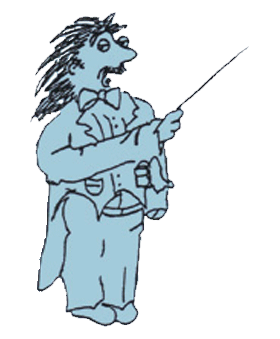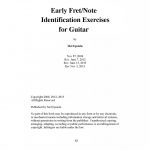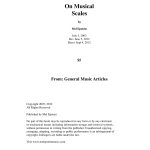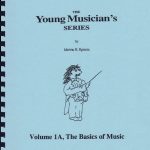Levels Description
You will find a Levels designation associated with each of the publications displayed at this site.
While every publisher seems to have their own particular slant on what exactly constitutes each of the standard levels, there is also a general consensus on what each level represents.
The levels that are used here include Beginner, Advanced Beginner, Early Intermediate, Intermediate, Advanced Intermediate, Early Advanced and Advanced.
Our purpose in referencing these levels is to help you locate material that is more or less at or close to your current range of playing skill and knowledge. By giving you a better idea of the relative ease or difficulty of a particular song or book or article, we hope that you can better choose material that’s right for you.
Also, you may be more skilled in some aspects of playing than in others, so that should be kept in mind when choosing a book or exercise guide or song.
Our intent is that you find and work on items that are neither completely easy nor completely difficult. Ideally, you would select publications that you can generally understand but not already play well and easily without additional effort and study. Initial difficulty is not a bad sign. Keeping at it will eventually win out and give you the enormous satisfaction that comes from such persistence.
Following are elaborations on what to expect at each level.
Beginner
Student is just starting out or returning after a long break.
Pieces typically are limited to quarter, half and whole notes.
Time signatures include 4/4 and 3/4 time. Slower tempos are employed.
Pieces are typically not more than one page long.
At first, notes are often lettered to assist recognition.
No knowledge of music theory is assumed.
Eventually, tied notes are introduced.
On stringed instruments, all playing is done in first position and movement between strings is tightly controlled. On keyboards, notes are organized first in Middle C position, then in C position.
Chord symbols are not yet included in the performance of the pieces. In a bit, two note chords are included as notes to be played together.
Advanced Beginner
Student has a feel for note flow, basic musical structure, unlettered note recognition, relative note length and basic agility in locating and sounding notes at their respective position on the neck or keyboard.
Student is familiar with the first few notes on each string.
The material is still fairly easy, but certain elementary points are no longer explained.
Eighth notes are introduced, as are a very limited number of sharps and flats.
Brief excursions from the first into second and third position notes occur.
Basic first position chords are learned, such as C, G, Am, Em, D, Bm, and F (assimple triads), along with the appearance of arpeggios and simple strum patterns.
Typically, there are occasionally two chords per measure.
On stringed instruments, alternate picking is learned and used. Inter-string movement is expanded, with some string skipping.
Pieces are now two to three pages long.
Early Intermediate
Double Stops and open power chords are presented.
Slightly more complex strum patterns are used.
TAB is introduced (if not done earlier)
Basic slurs (hammer-ons, pull-offs, slides and bends) are taught.
More complex note patterns and rhythms appear.
Now learns about second and third position playing.
Sixteenth notes are now presented.
There is more rhythmic complexity, for example, the inclusion of syncopation (dotted quarter note followed by an eighth note or notes not on the beat) and swung eighth-notes.
The tempo for eighth notes increases in speed.
Triplets (quarter note and eighth note) are taught.
Keys/Chords expand to include those such as B, Gm, A, Fm, E, Cm, E, F, Dm.
Various musical styles are now built into the pieces studied.
Introduction of slash chords, extended and altered chords (e.g. various 7th chords, augmented, diminished, chords with omitted notes, differently placed chords).
Finger-style playing on the guitar is now included.
Intermediate
Barre chords (half and full barre) are taught and used.
Moveable power chords are included.
Scales are taught (major, minor, pentatonic), along with moveable scale shapes
The student is introduced to fifth position playing on stringed instruments.
There may be more than two chords in a measure.
More embellished chords are now visible.
Advanced Intermediate
Modes are introduced and used.
Fifth and seventh position playing is evident.
Notes up the neck, especially on the sixth and fifth strings appear.
Wider position shifts (up to fifth and sixth position) occur, as do wider string skips.
There is an increased conceptual element in the material studied.
Grace notes are employed.
Open tunings may be taught here, if not done earlier.
More sophisticated accompaniments make their presence.
Simple counterpoint shows up.
Trill/vibrato technique is introduced.
Improvisation may be undertaken here.
Pieces may be even now longer now.
Early Advanced
Compound meter, 9/8, and simple meter changes appear, as do dotted sixteenth notes.
Wide position shifts are written in to the music (From first to ninth and above positions)
The compositions in general are more sophisticated, demanding greater technical prowess.
Melodies are now harmonized with eighth notes
Tempos may be much faster.
Music will be written in more advanced keys, such as E and Eb Major, B and Bb Major, f# minor, c# minor.
Advanced
Positions at and above the ninth are included.
Two octave arpeggios are evident.
More ornamentation in both the melody and harmony is now present.
A high level of cross-picking is evident, along with many passing and chromatic tones.
Sixteenth notes are expected to be played at fast tempos.
Counterpoint is more complex and intricate.
Complex fingering and finger combinations is prevalent.
Pieces are 5 pages or longer
Multiple
This level name is used to designate material which span a large range of skill levels, so it should be beneficial to any student of music.






